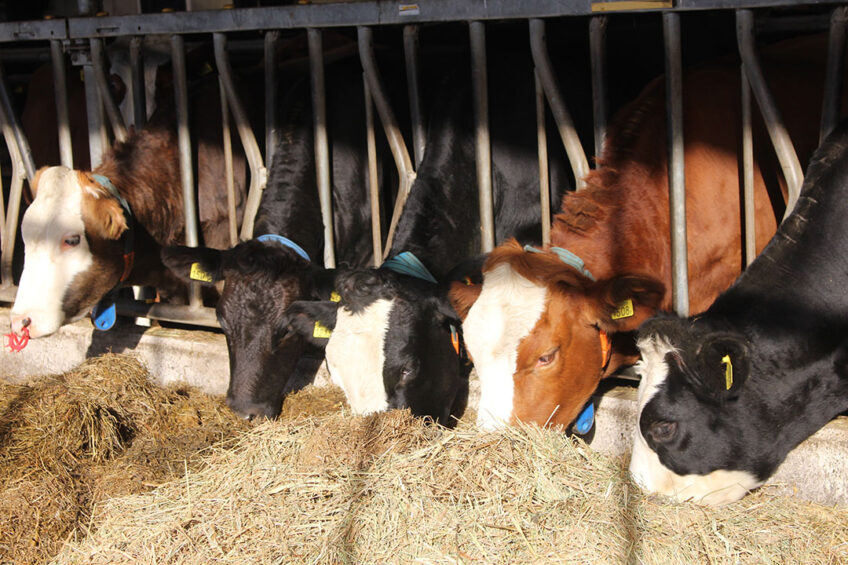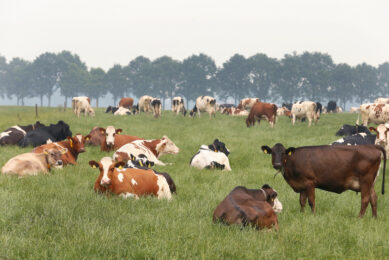3-NOP: Effective methane inhibitor in dairy cows

A new research published in the Journal of Dairy Science reviews that the anti-methanogenic 3-NOP (3-nitrooxypropanol) has high potential in inhibiting enteric CH4 emission in lactating dairy cows.
The researchers noted that some previous studies have shown consistent effects of 3-NOP on enteric CH4 emission. However, these studies have not conclusively determined its effects on milk production and composition, which is important for future adoption of this CH4 mitigation practice. Therefore, they focused their research on both the reduction on enteric methane production and the effects on milk production and composition.

Due to its molecular structure, 3-NOP is highly soluble and rapidly metabolised in the rumen where it has its beneficial effect. The 3-NOP molecule is a specific inhibitor of methyl-coenzyme M reductase, the enzyme involved in the biological synthesis and anaerobic oxidation of CH4 in methanogenic archaea. To be specific, 3-NOP inhibits the reduction of CO2 by dissolved H2 to form CH4 by targeting the active site of methyl-coenzyme M reductase in the terminal step of methanogenesis in the rumen.
Mitigating methane production in the rumen
Several feeding strategies can be adopted to reduce methane production in the rumen. In this article, however, the focus is on the use of fat supplements in the animal’s diet. Read more…
The study: Effect on methane emission & milk production and composition
The study examined the effect of 3-nitrooxypropanol (3-NOP) on enteric methane emission, and milk production and composition in Holstein dairy cows. A total of 48 multi- and primiparous cows averaging 43 kg/d milk yield and weighing about 594 kg were randomly assigned to 2 treatment groups:
- control, no 3-NOP
- 3-NOP supplemented at 60 mg/kg DM feed.
The authors also evaluated a dose-response effect of 3-NOP when supplemented at 40, 60, 80, 100, 150, and 200 mg/kg of DM feed.
Reducing enteric methane production
Compared with the control group, 3-NOP applied at 60 mg/kg feed dry matter decreased daily methane emission, emission yield, and emission intensity by 26, 27, and 29%, respectively. The CH4 per energy-corrected milk was also decreased by 29%. When a dose-response test was employed, the 150 mg/kg feed had the highest methane reduction percentage (36%), although the difference between 100, 150, and 200 mg was not significant. To further assess the anti-methanogenic effect of 3-NOP, the researchers measured the production of hydrogen; this was 6-fold greater for 3-NOP cows over the 15-week treatment period compared to the control group. They mentioned the increase in H2 emission to be directly associated with the inhibition of methanogenesis by 3-NOP, since methanogenesis is one of the main H2 sinks in rumen fermentation.
Figure 1. Effect of dietary supplementation with 3-NOP on enteric methane reduction in dairy cows

Milk production and composition
The dry matter intake, and milk yield and lactose content were not affected by 3-NOP supplementation at 60 mg/kg DM feed. On the other hand, the energy-corrected milk yield, milk true protein, and milk solids were increased. Interestingly, milk fat concentration and yield were also increased by 3-NOP; this was attributed to increased concentration of de novo synthetised short-chain fatty acids in milk. In addition, supplementing 3-NOP at 60 mg/kg reduced the somatic cell counts by 37%.
 5 ways nutritionists can reduce methane in dairy cows
5 ways nutritionists can reduce methane in dairy cows
Dr Sophie Parker-Norman looks at what are the exact applications and options for CH4 mitigation in ruminant nutrition, and when will we see them in action? Read more…
Energy availability and feed utilisation efficiency
According to previous studies, enteric CH4 represents an energy loss of 2-12% of the total feed energy consumed by ruminants. Although it has been suggested that inhibition of methanogenesis may provide extra ME that can be used for production purposes, in this study, 3-NOP inclusion did not increase milk yield, neither did it improve feed utilisation efficiency. The researchers pointed out that the extra ME energy from inhibited methanogenesis was possibly redirected towards milk fat synthesis – concentrations of de novo synthesised fatty acids in milk fat were increased by 3-NOP, suggesting increased energy availability.
These results suggest that 3-NOP is a promising feed additive for reducing enteric CH4 emissions, maintaining lactational performance and potentially increasing milk fat yield,”
Administration and dosage
They concluded that the administration of 3-NOP via the total mixed ration at an inclusion range of 0 to 200 mg/kg DM feed decreases enteric CH4 emissions by 22 to 40%, and the emission intensity by an average of 33%. Maximum mitigation effect of 3-NOP was achieved at 150 mg/kg DM feed, but no significant differences were observed among the 3 highest doses (100, 150, and 200 mg/kg). DM intake and milk yield were not affected, but milk fat concentration and yield were increased, suggesting increased energy availability. In a similar study, researchers determined the effect of 3-NOP on enteric methane emissions when 3-NOP was mixed in with roughage or incorporated into a concentrate pellet: their results showed that 3-NOP can reduce enteric CH4 emissions when incorporated into a concentrate pellet and that this reduction is not different when 3-NOP is mixed with the basal diet (roughage). This broadens the possibilities of using 3-NOP in the dairy sector worldwide, since provision of additives mixed in the basal diet is not always feasible.
“These results suggest that 3-NOP is a promising feed additive for reducing enteric CH4 emissions, maintaining lactational performance and potentially increasing milk fat yield,” they concluded.
This article is based on the original article by A. Melgar, C. F. A. Lage, K. Nedelkov, et al. 2020. Enteric methane emission, milk production, and composition of dairy cows fed 3-nitrooxypropanol. J. Dairy Sci. 104:357–366. 10.3168/jds.2020-18908.
Join 13,000+ subscribers
Subscribe to our newsletter to stay updated about all the need-to-know content in the dairy sector, two times a week.










